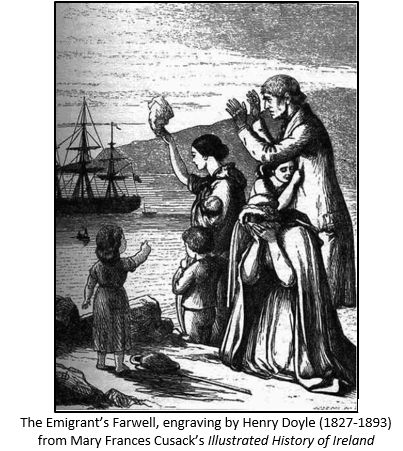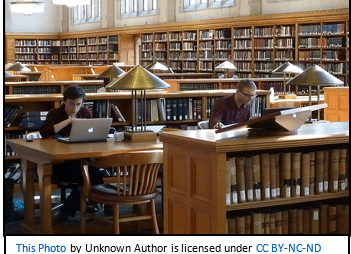Irish Emigration – Part 2 : The Records
 24
24Mar

Often when searching for our Irish ancestor, we begin by searching immigration records, those kept by the country of arrival. But finding emigration records, or records in Ireland for your departing family, can be a real challenge. Unfortunately, emigration records in Ireland were not systematically kept as a country-wide program. Happily, new Irish emigration records continue to come to light, and more and more are becoming accessible in repositories and/or online every day.
One of the best places to begin your research is in the Irish Emigration Database (IED), created by the Mellon Centre for Migration Studies located in County Tyrone, Ireland. The database is a virtual archive of original primary material, which has been transcribed, digitized and is key-word searchable! The records are focused only on migration to North America from 1700 to 1950 and is heavily weighted toward Ulster, but include such items as emigrant letters, family papers and diaries, newspaper articles, shipping advertisements, and passenger lists.
Ancestry.com has dozens of unique databases in their “Immigration & Emigration” section of the website. David Dobson published “Irish Emigrants in North America” based on source material from Scotland, England, Canada, Denmark, the United States, Canada, and Ireland. The Canada, Immigration and Settlement Correspondence and Lists, 1817-1896 includes letters and other materials from the Colonial Office and related organizations dealing with emigration. Among the many valuable sources is a record nicknamed “The McCabe List.” Its creation was prompted by a questionnaire from the British parliamentary committee to the Irish who had emigrated under the Honourable Peter Robinson. Among the questions asked were: from whence did you emigrate, what family had you with you, and would you recommend a poor family to come out to Upper Canada if the government advanced the passage money, 100 acres of land, and provisions for a year, on condition that the advance be repaid out of the produce of the farm in annual instalments. Beginning in 1829, the names of 635 Irish emigrants are recorded, but even more remarkable are the comments associated with each name referring to the emigrant’s relations still in Ireland who also wanted to emigrate to Canada.

FindMyPast.com has over 24 million entries and images in Passenger Lists Leaving UK 1890-1960. There is no single standard format, as the lists changed over time and depending on the shipping line. There is no way to sort out the Irish among other British residents, but you can search by departure port. Another incredible database is British & Irish Roots Collection which uses 98 million records to identify over 63 million British or Irish emigrants. If your ancestor was Quaker, the database Society Of Friends (Quaker) Migration Records includes those who left the country, including this account of Mary Smith in the Dublin Monthly Meeting of 25 Nov 1731:
To Friends of Pensylvania in America,
Dear Friends, Whereas Mary Smith who sometime ago Transported Herself from hence, and now (as we understand) Resideth among you, and hath by her Mother Requested a few lines from us – Respecting her Converationale.
These may therefore Certifie that She was Educated amongst us in the Profession of Truth and as far as we know was of an orderly conversation and upon Enquiry we do not find but that she left this City clear from all men on acct of Marriage, So Desiring her Preservation and Welfare every way. Recommend her to you and with the Saluation of Unfeigned love in the Blessed Truth Remain your Friends and Brethren.
Signed…
Sometimes letters home were published in the newspapers, which can be checked on The British Newspaper Archive, offered in conjunction with FindMyPast. You can also try searching Newspapers.com, offered in conjunction with Ancestry (currently only offering papers from Dublin, Waterford, and Meath). Government emigration schemes, migration groups, or forced transportation may also be mentioned. You can narrow your search by date, newspaper, or location. In this 1865 Dublin newspaper, The Irish People, a list of deaths in America was published. From the death notice of Mr. Hugh Keating, we learn that he emigrated to America in 1816 and settled in Pittsburgh.
[caption id="attachment_7810" align="aligncenter" width="578"] Immigrant Ancestors Project | Price Genealogy[/caption]
Immigrant Ancestors Project | Price Genealogy[/caption]
The Center for Family History and professional genealogy at BYU has created the Immigrant Ancestors Project. Drawing from migration material in repositories all over Europe, it is another valuable resource for finding emigration records. For example, they have the records for “Castlecomer Poor Law Union Assisted Emigrants 1847-1853.” Information includes the emigrant’s name, township, and how much money was given to the families to emigrate by each parish. There’s also “Irish Emigrant Personal Accounts 1838-1901,” and “Irish Emigrant Letters 1842-1910,” among others.
Local repositories hold many valuable emigration records and should not be overlooked. Both the Public Record Office of Northern Ireland (PRONI) and The National Archives in Dublin have numerous emigration records. For example, PRONI has the session book for the Ballyenon Reformed Presbyterian Church, which includes a register of those who left the congregation (including emigrants) between 1849 and 1868. You might find journals, such as the detailed account of John Martin’s voyage from Ireland on the convict ship Mountstuart Elphinstone to Australia from 1849 to 1850. Search for the name of your ancestor or their townland/parish of origin and you might be surprised by what you find!
FamilySearch also has many published and microfilmed emigration records. These may be located by searching the Catalog for “Emigration and immigration,” under both the country and parish level. If your ancestor was sentenced to transportation to Australia, check the Transportation Registers from 1836 to 1857. The records include the name, age, offence, sentence, date and place of conviction, date of transportation and gaolers’ comments. If your ancestor came between March 1803 and March 1806, check Brian Mitchell’s extracted names from the “Hardwick Papers,” which includes a list of passengers sailing from Ireland to America. The records include name, age, occupation, and place of abode. You may stumble upon other occasional passenger lists, such as the list of passengers on the J & J Cooke line and McCorkell line that sailed from Londonderry to America from 1847-1871. These lists identify the residence of the passengers.
During the Great Famine, state-aided emigration schemes were common. In 1960, Analecta Hibernica, the official academic journal of the Irish Manuscript Commission, published a manuscript of “State-aided emigration schemes from crown estates in Ireland,” republished by Eilish Ellis and available through FamilySearch. The estates include parishes in the counties of Roscommon, Galway, Cork, and Kerry. The “Irish Reproductive Loan Fund, 1821-1874,” is also searchable at the FamilySearch Library. This micro credit scheme provided small loans to the ‘industrious poor.’ The financial records list the applicant’s address and occupation, but additional detail is often given in the local association records, including notes on health, family circumstances, and emigration.
Records on FamilySearch may also be found on the parochial level. The parish records for the Roman Catholic parish of Stamullin in County Meath include a list of parishioners who emigrated from 1863 to 1873. The parish clerk wrote down the name of the emigrant, their occupation, when they left the parish, marital status, residence, age, and final destination. John Grenham has compiled a list of sources for each parish on Irish Ancestors which may include emigration records.
To summarize, finding your ancestor’s Irish emigration record may prove difficult. There is not one localized database containing all extant emigration records, and this article is not comprehensive in listing all the websites and archives where records may be found. However, starting your search with these key sites and repositories will get you headed in the right direction. And never hesitate to reach out to a local historical society, library, or archive to ask for help using their collections.

And if you still feel overwhelmed, reach out to Price Genealogy and let us help you with your Irish emigration!
By Emily
Bibliography
Ancestry, Canada, Immigration and Settlement Correspondence and Lists, 1817-1896: Vol. 22 – North American Emigration Societies; Individuals, 1829, image 87 of 135 (https://www.ancestry.com/discoveryui-content/view/2701:3709?tid=&pid=&queryId=f112b936c3fecb6fb674550fe34432ca&_phsrc=QIY1131&_phstart=successSource: accessed 10 March 2023).
FindMyPast, Ireland, Society Of Friends (Quaker) Migration Records, Dublin Monthly Meeting, Mary Smith, 25 Nov 1831; index with images, image 54 of 136 (https://www.findmypast.com/transcript?id=IRE%2FQUAKER%2FMIG%2F954: accessed 10 March 2023).
Newspapers.com, The Irish People, 11 Feb 1865, Sat, Page 4, Dublin, Dublin, Ireland (https://www.newspapers.com/image/59288317/?terms=hugh%20keating&match=2: accessed 10 March 2023).
Timeline Genealogy in Ireland, “Two Unusual Irish Emigration Records” by Dr. Robert Somerville Woodward [no date] (https://timeline.ie/irish-emigration-records/: accessed 9 March 2023).
FamilySearch Wiki, Ireland Emigration and Immigration, last edited 5 March 2023 (https://www.familysearch.org/en/wiki/Ireland_Emigration_and_Immigration: accessed 9 March 2023).
James G. Ryan, “Irish Records: Sources for Family and Local History.” The Flyleaf Press: Dublin, Ireland, 1997.
